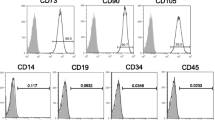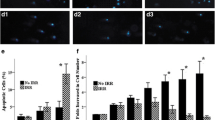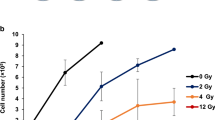Abstract
Ionizing radiation (IR) is an important medical tool. Despite the effects associated with high-dose radiation during or after treatment, as well as in accidental exposures, the direct or indirect effect of low-dose IR in cells remain poorly documented. IR can affect the tissue microenvironment, including mesenchymal stem cells (MSCs), which have high regenerative and immunomodulatory capacities. This study aimed to investigate the effect of low-dose IR in association with the inflammatory stimuli of TNF-α on the immunomodulatory capacity of MSCs. MSCs were irradiated with a low-dose IR, stimulated with TNF-α, and cultivated in a bystander system with murine spleen cells. The results showed that TNF-R1 is expressed in MSCs and is not affected, even in irradiated MSCs. However, irradiated MSCs produced reduced amounts of IL-6 and increased amounts of IL-10. The levels of PGE2 and NO• in MSCs were also increased when stimulated with TNF-α. Furthermore, conditioned media from irradiated MSCs reduced the proliferation of bystander lymphocytes and reduced the metabolic activity of macrophages. In addition, conditioned media from irradiated MSCs modulated the profile of cytokines in bystander spleen cells (lymphocytes and macrophages), reducing inflammatory and increasing anti-inflammatory cytokines, also increasing Treg cells. In conclusion, low-dose IR in association with an inflammatory stimulus affects the immunomodulatory properties of MSCs. In this way, the immunosuppressive capability of MSCs can be explored for several disease treatments where IR usually part of the context of the treatment. However, a complete understanding of the mechanisms underlying these interactions need further investigation.

Graphical Abstract






Similar content being viewed by others
References
Stefani, F. R., Eberstål, S., Vergani, S., Kristiansen, T. A., & Bengzon, J. (2018). Low-dose irradiated mesenchymal stromal cells break tumor defensive properties in vivo. International Journal of Cancer, 143(9), 2200–2212. https://doi.org/10.1002/ijc.31599.
Harrell, C. R., Jovicic, N., Djonov, V., & Volarevic, V. (2020). Therapeutic use of Mesenchymal stem cell-derived Exosomes: From basic science to clinics. Pharmaceutics, 12(5), E474. https://doi.org/10.3390/pharmaceutics12050474.
Kyurkchiev, D., Bochev, I., Ivanova-Todorova, E., Mourdjeva, M., Oreshkova, T., Belemezova, K., & Kyurkchiev, S. (2014). Secretion of immunoregulatory cytokines by mesenchymal stem cells. World Journal Stem Cells, 6, 552–570. https://doi.org/10.4252/wjsc.v6.i5.552.
De Miguel, M. P., Fuentes-Julián, S., & Blázquez-Martínez, A. (2012). Immunosuppressive properties of mesenchymal stem cells: Advances and applications. Current Molecular Medicine, 12, 574–591. https://doi.org/10.2174/156652412800619950.
Wang, Y., Chen, X., Cao, W., & Shi, Y. (2014). Plasticity of mesenchymal stem cells in immunomodulation: Pathological and therapeutic implications. Nature Immunology, 15, 1009–1016. https://doi.org/10.1038/ni.3002.
Prise, K. M., & O’Sullivan, J. M. (2009). Radiation-induced bystander signalling in cancer therapy. Nature Reviews Cancer, 9(5), 351–360. https://doi.org/10.1038/nrc2603.
Wakeford, R., & Tawn, E. J. (2010). The meaning of low dose and low dose-rate. Journal of Radiological Protection, 30(1), 1–3. https://doi.org/10.1088/0952-4746/30/1/E02.
Arnold, K. M., Flynn, N. J., Raben, A., Romak, L., Yu, Y., Dicker, A. P., Mourtada, F., & Sims-Mourtada, J. (2018). The impact of radiation on the tumor microenvironment: Effect of dose and fractionation schedules. Cancer Growth Metastasis, 11, 1179064418761639. https://doi.org/10.1177/1179064418761639.
Short, S. C., Bourne, S., Martindale, C., Woodcock, M., & Jackson, S. P. (2005). DNA damage responses at low radiation doses. Radiation Research, 164(3), 292–302. https://doi.org/10.1667/rr3421.1.
Schröder, S., Kriesen, S., Paape, D., Hildebrandt, G., & Manda, K. (2018). Modulation of inflammatory reactions by low-dose ionizing radiation: Cytokine release of murine endothelial cells is dependent on culture conditions. Journal of Immunology Research, 2856518, 1–13. https://doi.org/10.1155/2018/2856518.
Barcellos-Hoff, M. H., Park, C., & Wright, E. G. (2005). Radiation and the microenvironment – Tumorigenesis and therapy. Nature Reviews Cancer, 5(11), 867–875. https://doi.org/10.1038/nrc1735.
Tsai, K. K. C., Chuang, E. Y., Little, J. B., & Yuan, Z. M. (2005). Cellular mechanisms for low-dose ionizing radiation-induced perturbation of the breast tissue microenvironment. Cancer Research, 65(15), 6734–6744. https://doi.org/10.1158/0008-5472.CAN-05-0703.
Xu, T., Zhang, Y., Chang, P., Gong, S., Shao, L., & Dong, L. (2018). Mesenchymal stem cell-based therapy for radiation-induced lung injury. Stem Cell Research Therapy, 9(1), 18. https://doi.org/10.1186/s13287-018-0776-6.
Yan, L., Zheng, D., & Xu, R. H. (2018). Critical role of tumor necrosis factor signaling in mesenchymal stem cell-base therapy for autoimmune and inflammatory diseases. Frontiers Immunology, 9, 1658. https://doi.org/10.3389/fimmu.2018.01658.
Crisotomo, P. R., Wang, Y., Markel, T. A., Wang, M., Lahm, T., & Meldrum, D. R. (2008). Human mesenchymal stem cells stimulated by TNF-α, LPS, or hypoxia produce growth factors by an NFκB- but not JNK-dependent mechanism. American Journal Physiology-Cell Physiology, 294(3), C675–C682. https://doi.org/10.1152/ajpcell.00437.2007.
Hehlgans, T., & Pfeffer, K. (2005). The intriguing biology of the tumour necrosis factor/tumour necrosis factor receptor superfamily: Players, rules and the games. Immunology, 115(1), 1–20. https://doi.org/10.1111/j.1365-2567.2005.02143.x.
Roederer, M. (2001). Spectral compensation for flow cytometry: Visualization artifacts, limitations, and caveats. Cytometry, 45(3), 194–205. https://doi.org/10.1002/1097-0320(20011101)45:3<194::aid-cyto1163>3.0.co;2-c.
Livak, K. J., & Schmittgen, T. D. (2001). Analysis of relative gene expression data using real-time quantitative PCR and the 2(−Delta Delta C(T)) method. Methods, 25, 402–408. https://doi.org/10.1006/meth.2001.1262.
Lima, F. S., Romero, A. B. R., Hastreiter, A., Nogueira-Pedro, A., Makiyama, E., Colli, C., & Fock, R. A. (2018). An insight into the role of magnesium in the Immunomodulatory properties of Mesenchymal stem cells. The Journal of Nutritional Biochemistry, 55, 200–208. https://doi.org/10.1016/j.jnutbio.2018.02.006.
Oliveira, D. C., Hastreiter, A. A., Mello, A. S., Beltran, J. S. O., Santos, E. W. C. O., Borelli, P., & Fock, R. A. (2014). The effects of protein malnutrition on the TNF-RI and NF-κB expression via the TNF-α signaling pathway. Cytokine, 69(2), 218–225. https://doi.org/10.1016/j.cyto.2014.06.004.
Schmitt, C. A. (2007). Cellular senescence and Cancer treatment. Biochimica et Biophysica Acta, 1775(1), 5–20. https://doi.org/10.1016/j.bbcan.2006.08.005.
Archer, S. (1993). Measurement of nitric oxide in biological models. FASEB Journal, 7(2), 349–360. https://doi.org/10.1096/fasebj.7.2.8440411.
Tario, J. D., Muirhead, K. A., Pan, D., Munson, M. E., & Wallace, P. K. (2011). Tracking immune cell proliferation and cytotoxic potential using flow Cytometry. Methods Molecular Biology, 699, 119–164. https://doi.org/10.1007/978-1-61737-950-5_7.
Mosmann, T. (1983). Rapid colorimetric assay for cellular growth and survival: Application to proliferation and cytotoxicity assays. Journal of Immunology Methods, 65(1–2), 55–63. https://doi.org/10.1016/0022-1759(83)90303-4.
Di Nicola, M., Carlo-Stella, C., Magni, M., Milanesi, M., Longoni, P. D., Matteucci, P., Grisanti, S., & Gianni, A. M. (2002). Human bone marrow stromal cells suppress T-lymphocyte proliferation induced by cellular or nonspecific mitogenic stimuli. Blood, 99(10), 3838–3843. https://doi.org/10.1182/blood.v99.10.3838.
Abdi, R., Fiorina, P., Adra, C. N., Atkinson, M., & Sayegh, M. H. (2008). Immunomodulation by mesenchymal stem cells : A potential therapeutic strategy for type 1 diabetes. Diabetes, 57(7), 1759–1767. https://doi.org/10.2337/db08-0180.
Shen, F. H., Visger, J. M., Balian, G., Hurwitz, S. R., & Diduch, D. R. Systemically Administered Mesenchymal Stromal Cells Transduced With Insulin-Like Growth factor-I Localize to a Fracture Site and Potentiate Healing. Journal of Orthopaedic Trauma, 16(9), 651–659. https://doi.org/10.1097/00005131-200210000-00007.
Neuss, S., Becher, E., Wöltje, M., Tietze, L., & Jahnen-Dechent, W. (2004). Functional expression of HGF and HGF receptor/c-met in adult human mesenchymal stem cells suggests a role in cell mobilization, tissue repair, and wound healing. Stem Cells, 22(3), 405–414. https://doi.org/10.1634/stemcells.22-3-405.
Satoh, H., Kishi, K., Tanaka, T., Kubota, Y., Nakajima, T., Akasaka, Y., & Ishii, T. (2004). Transplanted mesenchymal stem cells are effective for skin regeneration in acute cutaneous wounds. Cell Transplantation, 13(4), 405–412. https://doi.org/10.3727/000000004783983765.
Yang, H., Asaad, N., & Held, K. D. (2005). Medium-mediated intercellular communication is involved in bystander responses of X-ray-irradiated normal human fibroblasts. Oncogene, 24(12), 2096–2103. https://doi.org/10.1038/sj.onc.1208439.
Sugrue, T., Lowndes, N. F., & Ceredig, R. (2013). Mesenchymal stromal cells: Radio-resistant members of the bone marrow. Immunology Cell Biology, 91(1), 5–11. https://doi.org/10.1038/icb.2012.61.
Ankrum, J. A., Ong, J. F., & Karp, J. M. (2014). Mesenchymal stem cells: immune evasive, not immune privileged. Nature Biotechnology, 32(3), 252–260. https://doi.org/10.1038/nbt.2816 Epub 2014 Feb 23.
Wang, Y., Chen, X., Cao, W., & Shi, Y. (2014). Plasticity of mesenchymal stem cells in immunomodulation: Pathological and therapeutic implications. Nature Immunology, 15(11), 1009–1016. https://doi.org/10.1038/ni.3002.
English, K. (2013). Mechanisms of mesenchymal stromal cell immunomodulation. Immunology & Cell Biology, 91(1), 19–26. https://doi.org/10.1038/icb.2012.56.
Uccelli, A., Moretta, L., & Pistoia, V. (2008). Mesenchymal stem cells in health and disease. Nature Reviews Immunology., 8(9), 726–736. https://doi.org/10.1038/nri2395.
Vieira, P. L., Christensen, J. R., Minaee, S., O'Neill, E. J., Barrat, F. J., Boonstra, A., Barthlott, T., Stockinger, B., Wraith, D. C., & O’Garra, A. IL-10-secreting Regulatory T Cells Do Not Express Foxp3 but Have Comparable Regulatory Function to Naturally Occurring CD4+CD25+ Regulatory T Cells. The Journal of Immunology, 172(10), 5986–5993. https://doi.org/10.4049/jimmunol.172.10.5986.
O'Garra, A., Vieira, P. L., Vieira, P., & Goldfeld, A. E. (2004). IL-10-producing and naturally occurring CD4+ Tregs: Limiting collateral damage. The Journal of Clinical Investigation, 114(10), 1372–1378. https://doi.org/10.1172/JCI23215.
Consentius, C., Akyüz, L., Schmidt-Lucke, J. A., Tschöpe, C., Pinzur, L., Ofir, R., Reinke, P., Volk, H.-D., & Juelke, K. (2015). Mesenchymal stromal cells prevent Allostimulation in vivo and control checkpoints of Th1 priming: Migration of human DC to lymph nodes and NK cell activation. Stem Cells, 33(10), 3087–3099. https://doi.org/10.1002/stem.2104.
Gordon, S. (2003). Alternative activation of macrophages. Nature Reviews Immunology, 3(1), 23–35. https://doi.org/10.1038/nri978.
Melief, S. M., Schrama, E., Brugman, M. H., Tiemessen, M. M., Hoogduijn, M. J., Fibbe, W. E., & Roelofs, H. (2013). Multipotent stromal cells induce human regulatory T cells through a novel pathway involving skewing of monocytes toward anti-inflammatory macrophages. Stem Cells, 31(9), 1980–1991. https://doi.org/10.1002/stem.1432.
Okeke, E. B., & Uzonna, J. E. (2019). The pivotal role of regulatory T cells in the regulation of innate immune cells. Frontiers in Immunology, 10, 680e. https://doi.org/10.3389/fimmu.2019.00680.
Duffy, M. M., Ritter, T., Ceredig, R., & Griffin, M. D. (2011). Mesenchymal stem cell effects on T-cell effector pathways. Stem Cell Research & Therapy, 2(4), 34. https://doi.org/10.1186/scrt75.
Ramasamy, R., Tong, C. K., Seow, H. F., Vidyadaran, S., & Dazzi, F. (2008). The immunosuppressive effects of human bone marrow-derived mesenchymal stem cells target T cell proliferation but not its effector function. Cellular Immunology, 251(2), 131–136. https://doi.org/10.1016/j.cellimm.2008.04.009.
O'Brown, Z. K., Van Nostrand, E. L., Higgins, J. P., & Kim, S. K. (2015). The inflammatory transcription factors NFκB, STAT1 and STAT3 drive age-associated transcriptional changes in the human kidney. PLoS Genetics, 11(12), e1005734. https://doi.org/10.1371/journal.pgen.1005734.
Arora, S., Hernandez, Y., Erb-Downward, J. R., McDonald, R. A., Toews, G. B., & Huffnagle, G. B. Role of IFN-gamma in regulating T2 immunity and the development of alternatively activated macrophages during allergic bronchopulmonary mycosis. The Journal of Immunology, 174(10), 6346–6356. https://doi.org/10.4049/jimmunol.174.10.6346.
Kaplan, M. H. (2013). STAT signaling in inflammation. JAKSTAT, 2(1), e24198. https://doi.org/10.4161/jkst.24198.
Wager, C. M. L., Hole, C. R., Wozniak, K. L., Olszewski, M. A., & Wormley Jr., F. L. STAT1 Signaling Is Essential for Protection Against Cryptococcus neoformans Infection in Mice. The Journal of Immunology, 193(8), 4060–4071. https://doi.org/10.4049/jimmunol.1400318.
Gaba, A., Grivennikov, S. I., Do, M. V., Stumpo, D. J., Blackshear, P. J., & Karin, M. (2012). IL-10 mediated Tristetraprolin induction is part of feedback loop that controls macrophage STAT3 activation and cytokine production. The Journal of Immunology, 189(5), 2089–2093. https://doi.org/10.4049/jimmunol.1201126.
Zhang, T. L. L., Joo, D., & Sun, S. C. (2017). NF-κB signaling in inflammation. Signal Transduction and Targeted Therapy, 2, 17023. https://doi.org/10.1038/sigtrans.2017.23.
Abumaree, M. H., Al Jumah, M. A., Kalionis, B., Jawdat, D., Al Khaldi, A., Abomaray, F. M., Fatani, A. S., Chamley, L. W., & Knawy, B. A. (2013). Human placental mesenchymal stem cells (pMSCs) play a role as immune suppressive cells by shifting macrophage differentiation from inflammatory M1 to anti-inflammatory M2 macrophages. Stem Cell Reviews and Reports, 9(5), 620–641. https://doi.org/10.1007/s12015-013-9455-2.
Acknowledgments
This work was supported by grants from the Fundação de Amparo a Pesquisa do Estado de São Paulo – FAPESP (grant number: 2018/25813-8). Fock RA is fellow of the Conselho Nacional de Pesquisa e Tecnologia (CNPq).
Author information
Authors and Affiliations
Corresponding author
Ethics declarations
Conflict of Interest
The authors declare that they have no conflict of interest.
Human and Animal Standard and Informed Consent
All procedures performed in studies involving animals were in accordance with the ethical standards of the University of São Paulo (CEUA/FCF/344).
Additional information
Publisher’s Note
Springer Nature remains neutral with regard to jurisdictional claims in published maps and institutional affiliations.
Rights and permissions
About this article
Cite this article
Nogueira-Pedro, A., Makiyama, E.N., Segreto, H.R.C. et al. The Role of Low-Dose Radiation in Association with TNF-α on Immunomodulatory Properties of Mesenchymal Stem Cells. Stem Cell Rev and Rep 17, 968–980 (2021). https://doi.org/10.1007/s12015-020-10084-9
Accepted:
Published:
Issue Date:
DOI: https://doi.org/10.1007/s12015-020-10084-9




